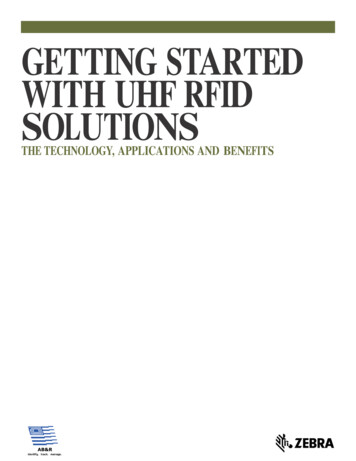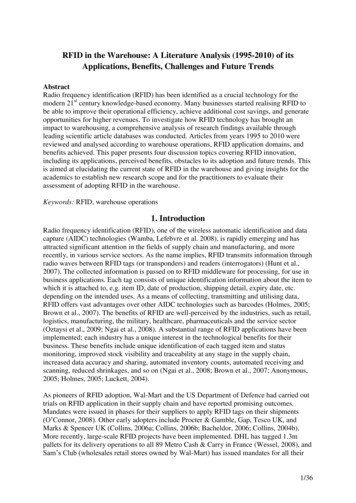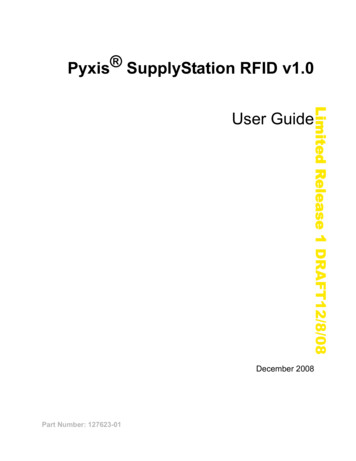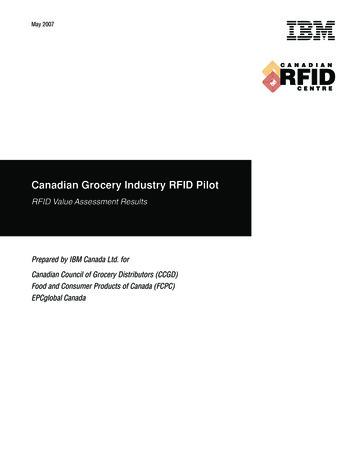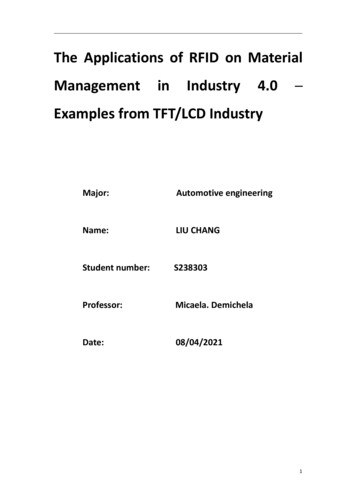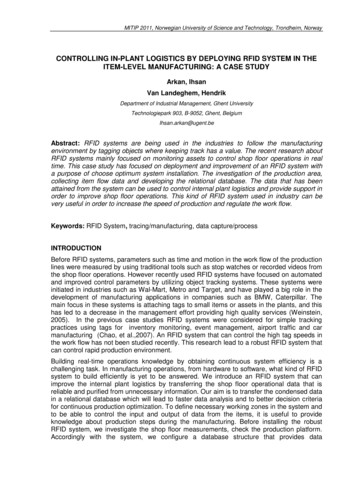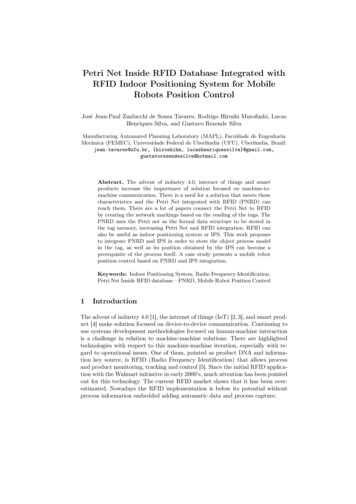
Transcription
Shi and Yan SpringerPlus (2016)5:2029DOI 10.1186/s40064-016-3708-xOpen AccessRESEARCHFactors affecting RFID adoptionin the agricultural product distributionindustry: empirical evidence from ChinaPing Shi1* and Bo Yan2AbstractWe conducted an exploratory investigation of factors influencing the adoption of radio frequency identification (RFID)methods in the agricultural product distribution industry. Through a literature review and field research, and basedon the technology–organization–environment (TOE) theoretical framework, this paper analyzes factors influencingRFID adoption in the agricultural product distribution industry in reference to three contexts: technological, organizational, and environmental contexts. An empirical analysis of the TOE framework was conducted by applying structuralequation modeling based on actual data from a questionnaire survey on the agricultural product distribution industryin China. The results show that employee resistance and uncertainty are not supported by the model. Technologicalcompatibility, perceived effectiveness, organizational size, upper management support, trust between enterprises,technical knowledge, competitive pressure and support from the Chinese government, which are supported by themodel, have significantly positive effects on RFID adoption. Meanwhile, organizational size has the strongest positiveeffect, while competitive pressure levels have the smallest effect. Technological complexities and costs have significantly negative effects on RFID adoption, with cost being the most significantly negative influencing factor. Theseresearch findings will afford enterprises in the agricultural products supply chain with a stronger understanding of thefactors that influence RFID adoption in the agricultural product distribution industry. In addition, these findings willhelp enterprises remain aware of how these factors affect RFID adoption and will thus help enterprises make moreaccurate and rational decisions by promoting RFID application in the agricultural product distribution industry.Keywords: Technology adoption, Agricultural product distribution industry, RFID, Structural equation modeling(SEM), Technology–organization–environment (TOE)BackgroundThe safety of agricultural products has become a centralsocietal issue, as safety not only affects consumer healthbut can also devastate agricultural produce enterprisesand the entire agricultural supply chain, seriously affecting the sustainable development of agricultural product industries and societal stability. As an importantaspect of food safety management, the traceability ofagricultural products plays a key role. China in particular is becoming the world’s largest food producer and*Correspondence: shiping2013@qq.com1School of Management, Guangdong University of Technology,Guangzhou 510520, ChinaFull list of author information is available at the end of the articleconsumer. Related policies that involve setting up uniform tracing information platforms and enacting standards are promoted widely. However, owing to the lengthyand dynamic nature of supply chains, traditionally wiredsensor technologies can barely address agricultural product monitoring needs. With the rapid development of theInternet of things (IOT) industry, radio frequency identification (RFID) has been applied extensively aroundthe world, and some developed countries have achievedfavorable results by using RFID to manage agriculturalsupply chain safety, in turn attracting interest from academics. Most studies on agricultural products basedon RFID technologies have focused on their applications, while the introduction of new technologies typically requires rigorous and scientific analysis to satisfy The Author(s) 2016. This article is distributed under the terms of the Creative Commons Attribution 4.0 International /), which permits unrestricted use, distribution, and reproduction in any medium,provided you give appropriate credit to the original author(s) and the source, provide a link to the Creative Commons license,and indicate if changes were made.
Shi and Yan SpringerPlus (2016)5:2029industry development requirements. Factors influencing RFID adoption have not yet been studied. By studying these issues, China can begin to promote agriculturalinformation management systems.Literature review and our contributionsLiterature reviewMany scholars have studied the applications of RFID foragricultural product management by exploring applications of RFID for agricultural products (Sahin et al. 2002;Regattieri et al. 2007; Amador et al. 2009; Abad et al.2009), the construction of agricultural product information systems (Gras 2006; Bernardi et al. 2007; Liu andTang 2010), and the quality management of agriculturalproducts based on RFID (Bernardi et al. 2007; Xie et al.2007; Jedermanna et al. 2009). While it is worthwhile tostudy applications of RFID in the agricultural productdistribution industry, few studies have examined factors that influence RFID adoption in agricultural product supply chains. In practice, RFID technologies havebeen implemented widely in some developed countriesthrough governmental and business projects (e.g., WalMart and DHL). Although the IOT industry is growing in China, related successful projects have been rare,with most still occupying the experimental stage. Chinahas lagged behind other developed counties in terms oftechnological, standard, supply chain and applicationdevelopment. Most related studies have attributed this tolower labor costs in China, to the higher costs of RFIDadoption and to undeveloped standards and regulations(Zhang 2011). The introduction of RFID into the agricultural product distribution industry thus serves as animportant premise for analyzing factors influencing RFIDadoption.Information technology adoption theory constitutesan emerging facet of information systems research. Itexamines the behavioral characteristics of organizationsand individuals as they adopt and accept informationtechnologies based on principles of social psychologyand behavioral science to determine ways in which usersaccept and continue to use information technologies (Li2006). The theory plays an important role in studying theintroduction of RFID technologies into the managementof agricultural products. Fichman (1992) summarizednumerous factors influencing information technologyadoption and classified information technology adoptiontheories into two categories: theories focused on individual-level adoption behaviors and those focused on organizational-level adoption behaviors. There are relativelyfew organization-level information technology adoption behavior theories (Li 2011). Some classic theoriesinclude Innovation Diffusion Theory (IDT), the six-stagemodel, and the TOE analysis framework. Tornatzky andPage 2 of 11Fleischer (1990) criticized IDT and maintained that classical innovation diffusion theory is critical of the notionthat factors affecting information technology adoption include not only technology elements (T) but alsocharacteristic elements of organizations (O) and environmental elements (E). After the technology–organization–environment (TOE) framework was first proposed,many scholars began to study TOE theory and relatedinfluencing factors due to its applicability. TOE theoryconsiders technological issues in terms of technical compatibilities, complexities, observability levels, etc. as wellas organizational factors such as the size of an organization, high-level support received, organizational cultures,etc. and environmental factors such as external competitive pressures and government policy support. Chau andTam (1997) used the TOE framework to analyze factorsthat affect open-system adoption. Kuan and Chau (2001)proposed a perception-based small business EDI adoption model tested against data collected from 575 smallfirms in Hong Kong based on the TOE theoretical framework. Grandon and Pearson (2004) examined determinant factors of strategic value and electronic commerceadoption as perceived by upper managers in small- andmedium-sized enterprises in the Midwest region of theUS. Zhang and Kang (2008) analyzed influencing factorsand countermeasures of logistics information networktechnologies. Li (2011) designed a process model for analyzing factors shaping RFID adoption in the automobilemanufacturing industry and applied it through a casestudy on China’s automobile manufacturing industry.Therefore, RFID technology application in the agricultural product distribution industry is bound to beaffected by various factors. Identifying these factors willplay a key role in RFID technology adoption. Processesand node enterprises in agricultural product supplychains constitute an organizational system. It is necessaryto analyze factors influencing RFID adoption through anexamination of entire organizations. We thus use organizational level adoption behavior theory to conduct thisstudy. TOE theory takes into account technical, organizational and environmental factors, thus forming a morecomprehensive framework.Our paper and contributionsFrom our study and summary of relevant literature, wedraw the following conclusions:(1) Research on factors influencing RFID adoptionin organizations is still relatively new, and withrespect to research focused on China, only Li (2011)designed a model for analyzing factors influencingRFID adoption in China’s automobile manufacturingindustry.
Shi and Yan SpringerPlus (2016)5:2029Page 3 of 11(2) For research methods, researchers initially usedqualitative analysis methods such as literaturereviews, case studies, and interviews with experts.More recently, researchers have conducted quantitative analyses such as questionnaires and statisticalanalyses.based on the following three contexts: technological,organizational, and environmental contexts. We conductan empirical analysis of the TOE framework by applyingstructural equation modeling (SEM) based on actual datadrawn from a questionnaire survey on the agriculturalproduct distribution industry in China.(3) In terms of research models, most related literaturehas employed Rogers’ diffusion of innovation theory(Rogers 1983). Other researchers prefer the TOEframework proposed by Tornatzky and Fleischer(1990).Hypotheses and the research modelTechnological, organizational, and environmentalcontexts form the basis of our comprehensive researchframework, and factors shaping RFID adoption withineach category are highlighted. From our literature review,factors influencing RFID adoption in the agriculturalproduct distribution industry are preliminarily summarized in Table 1. While Chinese governmental supportis rarely referenced in the extant literature, after contacting experts of this area, we found that the Chinese government plays an important role in the adoption of newinformation technologies. We thus take support from theChinese government into consideration.In sum, we conduct an exploratory investigation offactors that influence RFID adoption in the agriculturalproduct distribution industry. Using the TOE theoretical framework, we analyze factors that influencing RFIDadoption in the agricultural product distribution industryTable 1 The frequency of references to factors influencingRFID adoption in the related literatureCategoriesInfluencing factorsTechnological contextTechnological complexity5Technological compatibility3Perceived effectivenessOrganizational contextEnvironmental contextTimesTechnological context(1) Technological complexityThe more complex a form of technology is, the less possible it is for it to be successfully applied. When a form oftechnology is very difficult for an organization to apply,upper management teams determine to either abandonit or to introduce it later. Thus, we initially hypothesizedthat RFID complexity negatively affects adoption. Therefore, we propose the following:Hypothesis 1 Technological complexity has negativeeffects on RFID adoption.(2) Technological compatibilityWe define technological compatibility here as the degreeto which RFID corresponds with an organization’s business processes, IT infrastructure, distribution channels, corporate culture, and value system. Generally, it iseasier for an organization to employ a form of information technology when it offers a higher degree of technological compatibility. Hence, the following hypothesis isproposed:Hypothesis 2 Technological compatibility has a positive effect on RFID adoption.16Cost6Organizational size3Upper management support6Trust between enterprises2Technical knowledge4Employee resistance2Competitive pressure10Uncertainty4Chinese government support1(3) Perceived effectivenessThe presence of perceived effectiveness enables a higherdegree of supply chain visualization, saves time costs,reduces human resource costs, improves business efficiency levels, etc. Therefore, we propose that:Hypothesis 3 Perceived effectiveness has a positiveeffect on RFID adoption.
Shi and Yan SpringerPlus (2016)5:2029(4) CostTornatzky and Klein (1982) showed that costs inhibit theadoption of new technologies. In this paper, costs rangefrom hardware facility costs (including RFID/EPC tags,readers, sensors, middleware and servers) to costs of system implementation, integration, operation, and maintenance. Hence, the following hypothesis is proposed:Hypothesis 4adoption.Costs have a negative effect on RFIDOrganizational context(1) Organizational sizeLarge-scale enterprises have access to more resources fortesting out new forms of technology and can then determinewhether to adopt them or not. Meanwhile, they are morelikely to achieve economies of scale and to reduce risks associated with new technology adoption. They are also betterequipped to persuade supply chain partners to adopt newtechnologies. Hence, the following hypothesis is proposed:Hypothesis 5 Organizational size has a positive effecton RFID adoption.(2) Upper management supportWhen a new form of technology is adopted by an organization, this is bound to affect all aspects of the organization,altering business processes and organizational structures,which are all uncertain factors that shape new technologyadoption. When faced with such uncertainties, decisionmakers tend to initially exercise caution. Despite the benefits of RFID adoption, as such adoption can change existing business processes and requires financial support fromenterprises, upper management support is known to becritical to the adoption of new technologies in an organization. We thus propose the following:Hypothesis 6 Upper management attitudes towardsRFID positively affect RFID adoption.(3) Trust between enterprisesWhen strong cooperation and trust is not present, freeriding is likely to occur with RFID adoption, in whichcase upstream suppliers bear most of the incurred costs(Geng 2005). Thus, we propose the following:Page 4 of 11Hypothesis 7 Trust between enterprises has a positiveeffect on RFID adoption.(4) Technical knowledgeTechnical knowledge refers to professional IT knowledge owned by enterprises themselves. When theyhave grasped relevant knowledge and skills pertaining to a new form of technology, companies can effectively assess factors that influence the adoption ofthis new technology, including advantages, disadvantages, costs, etc. Therefore, the following hypothesis isproposed:Hypothesis 8 Technical knowledge has a positive effecton RFID adoption.(5) Employee resistanceWhen a new form of technology is adopted, someemployees may think that they do not have the necessaryqualifications or skills to operate this new form of technology. Meanwhile, as the introduction of new technologies increases operation efficiency levels while decreasinglabor force requirements, employees will worry aboutlosing their jobs and will therefore exhibit resistance tothe adoption of new technologies. Hence, the followinghypothesis is proposed:Hypothesis 9 Employee resistance has a negative effecton RFID adoption.Environmental context(1) Competitive pressurePremkumar and Ramamurthy (1995) discovered thatdue to internal pressures and a desire to gain a competitive advantage, enterprises must adopt new technologies. It is likely that they may also face not onlypressures resulting from technological innovationsgenerated by upstream and downstream partners inthe supply chain and by competitors but also pressuresresulting from new developments in business models and industry standards. Therefore, we propose thefollowing:Hypothesis 10 Competitive pressure has a positiveeffect on RFID adoption.
Shi and Yan SpringerPlus (2016)5:2029(2) UncertaintyA lack of information and technical knowledge or beingunable to forecast development patterns leads to uncertainty. It is quite typical for an enterprise to be unableto determine the requirements of their products or thenumber of loyal customers in the market. Therefore, thefollowing hypothesis is proposed:Hypothesis 11 Uncertainty has a negative effect onRFID adoption.(3) Chinese government supportPolicies and laws proposed by the Chinese governmentand financial support given will play an important role inpromoting the adoption of new technologies. In China,many companies are government-oriented, and whena new form of technology is supported by the Chinesegovernment, it will be widely adopted in the given industry quickly and easily. Hence, the following hypothesis isproposed:Hypothesis 12 Support from the Chinese governmenthas a positive effect on RFID adoption.The research model developed through this study is illustrated in Fig. 1. “ ” denotes that a factor has a positiveeffect on RFID adoption, whereas “ ” denotes that a factor has a negative effect.Research methodologySamples and data collectionDue to the limited amount of time the managerialrespondents could offer, a mail survey approach was usedto allow respondents to complete the surveys at theirconvenience. For reliability and operability purposes, werecruited staff members who are aware of supply chains,RFID and information technology observations. Upperlevel managers, middle managers, and professional stafffrom agricultural product distribution enterprises inFoshan and Guangzhou and Wal-Mart’s suppliers ofagricultural products in Shenzhen were studied, as theyare familiar with the requirements of running of a company and have a general understanding of new technologies such as RFID. Of these, 34 companies qualified andagreed to participate in the mailed survey. A contactperson from each company was selected to distributethe questionnaire to relevant staff members. Concerningof the professionalism of our questionnaire, we activelycommunicated with respondents to ensure the authenticity and reliability of our results, as errors can emergePage 5 of 11when respondents do not understand questions fully orwhen they ascribe too much subjective meaning to eachquestion.We studied 34 companies in total, and each companywas sent 3–5 sections of the questionnaire unequally.In total, 150 survey packages were sent out. Each survey package included a cover letter, questionnaire, andstamped return envelope. In total, 92 completed questionnaires were returned. However, nine responses werediscarded due to incomplete data. We received 83 validresponses, and the effective response rate was measuredat 55.3%. Demographic features of the respondents surveyed are shown in Tables 2 and 3. The respondents wereupper-level managers (8.7%), middle managers (21.7%),or professional staff members (69.6%). Regarding the sizeof each organization in terms of its number of employees,2.9% of the responses were classified as responses fromlarge firms (more than 1000 employees), 5.9% were classified as responses from medium-sized firms (501–999employees), 26.5% were classified as responses fromsmall firms (101–499 employees), and the remaining64.7% were classified as responses from firms with lessthan 100 employees.Measurement developmentMeasurement items used to operationalize the constructswere adapted from relevant previous studies. All scaleitems were rephrased to relate specifically to RFID andto the agricultural product supply chain. To facilitate ourdata analysis, each measurement item was measured ona 7-point Likert scale ranging from “strongly disagree”( 1) to “strongly agree” ( 7). Based on the previous context, definitions and analyses of each measurement itemare shown in Tables 4, 5, and 6.Technological contextSee Table 4.Organizational contextSee Table 5.Environmental contextSee Table 6.Data analysis and resultsThe structural equation modeling (SEM) method wasused to test the research model presented in Fig. 1. Thetwo-step approach presented by Anderson and Gerbing(1988) was used. First, the measurement model was estimated through a confirmatory factor analysis (CFA) totest the reliability and validity of the measurement model.The structural model was then analyzed to examine theoverall model fit.
Shi and Yan SpringerPlus (2016)5:2029Page 6 of rceivedeffectivenessH2 CostH3 OrganizationalcontextH4Organizational sizeH5 Upper managementsupportH6 Trust betweenenterprisesH7 stanceCompetitivepressureAdoption of RFIDH8 H9H10 H11-UncertaintyChinese governmentsupportH12 Fig. 1 The research modelTable 2 Descriptive statistics on the respondent positionsCategoriesUpper-level managersFrequency8Percentage8.7Table 3 Descriptive statistics on the respondent organization sizesCategoriesFrequencyPercentageMiddle managers2021.7Large enterprises12.9Professional staffs6469.6Medium-sized enterprises25.9Small enterprises926.5Micro enterprises2264.7The measurement modelThrough survey data analysis, it is easy to obtain theCronbach’s alpha reliability coefficient of latent variables(see Table 7). As is shown in Table 7, all Cronbach’s alphavalues exceeded the 0.70 threshold (Nunnally 1978),demonstrating adequate internal consistency. The Cronbach’s alpha estimates clearly denote reliability.The following results were derived from a Chi squaretest conducted using the AMOS 17.0 software program:CMIN 583.32, p 0.03, and at the 0.05 significancelevel, the null hypothesis is not rejected, denoting thatthe model fits well. Meanwhile, as is shown in Table 8,
Shi and Yan SpringerPlus (2016)5:2029Page 7 of 11Table 4 Measurement of technological contextsVariableStatement of measurementReferencesTechnological complexityT11: RFID system operation is complexBrown and Bakhru (2007) and Riggins and Slaughter (2006)T12: RFID system operation is inconvenientT13: RFID system operation requires ample experienceTechnological compatibilityT21: RFID technologies are compatible with businessprocessesRogers (1983) and Li (2011)T22: RFID technologies are compatible to other informationsystems (e.g., ERP, MIS and WMS)T23: RFID technologies complement knowledge held byagricultural product distribution enterprise employeesPerceived effectivenessT31: RFID technologies make agricultural product supplychains more transparent and improve visualizationcapacitiesKuan and Chau (2001), Brown and Russel (2007) andSeymour et al. (2010)T32: RFID technologies reduce labor costsT33: RFID technologies increase the operational efficiencyof agricultural product supply chains and cut time costsCostT41: Adopting RFID technologies will increase hardwarefacility costsT42: Adopting RFID technologies will increase operationsand maintenance costsTable 5 Organizational context measurementVariableStatement of measurementReferencesUpper management supportO21: Upper managers actively respond and pay attention when aproject is initiatedSharma et al. (2008) and Brown and Russel (2007)O22: Upper managers support labor resources, finances and materialsO23: Upper managers are willing to accept risks when adopting RFIDO22: Upper managers inspire employees to apply RFID technologiesin the daily work practicesTrust between enterprisesO31: Enterprises in the agricultural product supply chain have access Yang and Jarvenpaa (2005)to a strong mechanism for the distribution of benefitsO31: Enterprises in the agricultural product supply chain maintainstrong risk sharing mechanismsO33: Enterprises in the agricultural product supply chain cooperatewith one another and promote the adoption of this new form oftechnologyTechnical knowledgeO41: Enterprises in the agricultural product supply chain haverelevant technical knowledge on RFIDLeimeister et al. (2007) and Koh et al. (2011)O42: Enterprises in the supply chain have professional staff trainedin RFID useEmployees resistanceO51: Employees resist RFID adoption because they do not trust theirown abilitiesBhattacharya et al. (2009)O52: Employees worry about losing their jobs as a result of RFIDadoptionO53: Employees have become accustomed to bar code scanningthe other fitting indexes are GFI 0.961, NNFI 0.83,CFI 0.912, and RSMEA 0.063. The NNFI values areclose to the rational values, and the remaining indicatorsfall within an acceptable range. The measurement modelthus exhibits reasonable model fit to the data.The structural modelThe purpose of this study was to develop a strongerunderstanding of factors that influence RFID adoptionin the agricultural product distribution industry andof the degree to which each factor has an effect. To test
Shi and Yan SpringerPlus (2016)5:2029Page 8 of 11Table 6 Environmental context measurementVariableStatement of measurementReferencesCompetitive pressureE11: Competitive pressures force enterprises adopt RFIDtechnologiesSharma et al. (2008)E12: Social features such as cultures and customs affect RFIDadoptionE13: Partners call for RFID adoptionUncertaintyE21: The diversity of consumer demandsLeimeister et al. (2007) and Riggins and Slaughter (2006)E22: Consumer demands change frequentlyE23: Fast-paced technological developmentE24: Competitors adopt advanced technologiesChinese government supportE31: RFID development receives financial support from theChinese governmentLi (2006)E32: Relevant policies introduced by the Chinesegovernment boost RFID developmentTable 7 Cronbach’s alpha reliability coefficient of latent variablesCategoriesLatent variablesNumberof itemsCronbach’s alphaTechnological contextTechnological complexity30.710Technological compatibility30.723Perceived effectiveness30.810Cost20.922Upper management support40.789Trust between enterprises30.791Technical knowledge20.814Employee resistance30.865Competitive pressure30.914Uncertainty40.817Chinese government support20.866Willing to adopt20.927Organizational contextEnvironmental contextAdoptionTable 8 Fit indexes of the measurement modelFit indicesRecommended valueaActual valueChi squareLower values are better583.32Comparative Fit Index (CFI) 0.900.912Goodness-of-Fit Index (GFI) 0.800.961Non-normed Fit Index (NNFI) 0.900.83Root mean square error of approximation (RMSEA) 0.1, adequate goodness of fit; 0.05, strong goodness of fit0.063aRecommended values for concluding “good” model fit to the data (Hair et al. 1998)influencing factors, twelve hypotheses were proposedin “Hypotheses and the research model” section. A pathcoefficient (regression coefficient among latent variables)significance test similar to the parameter significancetest conducted for the regression analysis was then conducted. We used AMOS software to conduct our pathanalysis. The AMOS software program offers a simpleand effective way to determine the critical ratio (CR),
Shi and Yan SpringerPlus (2016)5:2029Page 9 of 11which is a Z statistic based on the ratio of parameterestimates and their standard deviations. When using theAMOS software for analyses, the p value is given at thesame time. We thus carried out our test based on the pvalue. A significance level of 0.01 was used in this study.Table 9 presents standard estimates of the path coefficient, the significance level, and the results. As is shownin Table 9, all the hypotheses were supported except forHypothesis 9 and Hypothesis 11.Based on the TOE framework, we studied factors influencing RFID adoption and used the SEM model andAMOS 17.0 software to carry out an empirical analysis ofthe agricultural product distribution industry in China.We found that the model accurately reflects RFID adoption in the agricultural product supply chain.The authors used the AMOS software program to conduct a path analysis. Ten of the twelve hypotheses weresupported. The path coefficient results are shown inFig. 2. It is important to note that the number listed oneach arrow denotes the effect of each factor. From ourpath coefficient significance test, it is clear that all of thefactors except for employee resistance and uncertaintyare supported by the model. Technological compatibility,perceived effectiveness, organization size, upper management support, trust between enterprises, technicalknowledge, competitive pressure levels and governmentsupport, which are supported by the model, have significant positive effects on RFID adoption. Among these,organization size has the strongest positive effect, whilecompetitive pressure has the least significant positiveeffect. Technological complexities and costs have significantly negative effects on RFID adoption. Among them,costs constitute the most significantly negative influencing factor.ConclusionsThrough our literature review and field research andbased on the TOE theoretical framework, we analyzedfactors that influence RFID adoption in the Chineseagricultural product distribution industry based onthree contexts: the technological, organizational, andenvironmental contexts. According to the results of ourempirical analysis, technological contexts involving technological complexities, technological compatibility, perceived effectiveness, and costs; organizational contextsinvolving organization sizes, upper management support,trust between enterprises, and technical knowledge; andenvironmental co
lyzing factors shaping RFID adoption in the automobile manufacturing industry and applied it through a case study on China's automobile manufacturing industry. Therefore, RFID technology application in the agri-cultural product distribution industry is bound to be affected by various factors. Identifying these factors will

